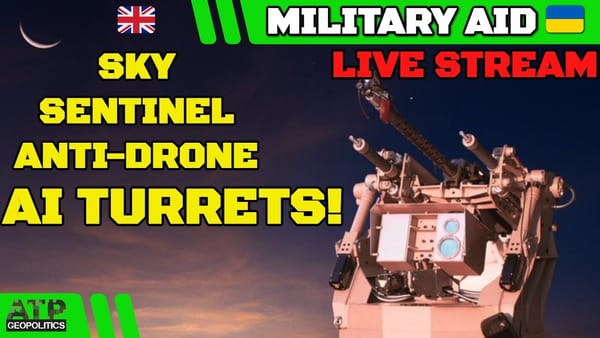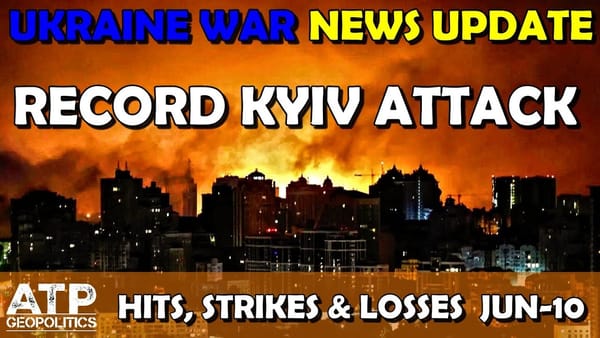Ukraine War Update NEWS: Military Aid News
Table of Contents 📖
"Russia is producing about 250,000 artillery munitions per month, or about 3 million a year"
Hello Team
🎦 00:00-00:13⏩
Jonathan welcomes everyone to the channel for part 2 of the Ukraine War News Update. This episode focuses on military aid. He explains he needs to split the videos up and do a geopolitical update later due to having a dentist appointment.
Return to top⤴️
Poland and US diplomacy
🎦 00:14-01:58⏩
Polish President Andrzej Duda and Prime Minister Donald Tusk will visit the US to lobby for greater military aid to Ukraine. Jonathan is sceptical about the impact this will have on US public opinion and highlights the backfire effect, where contrary evidence strengthens pre-existing views. He uses Marjorie Taylor Greene's reaction to David Cameron's similar attempts to illustrate the challenge of shifting entrenched opinions in the US.
Return to top⤴️
Czech Republic: Ukraine to receive 800,000 artillery shells
🎦 01:58-02:32⏩
Czech President Petr Pavel states that Ukraine will receive 800,000 artillery shells in the coming weeks, with the possibility of this increasing. He did not reveal which countries would supply the ammunition.
Return to top⤴️
Germany: Taurus missile "Ringtausch" increasingly likely
🎦 02:32-03:29⏩
German Foreign Minister, Fabian Hoffman, has indicated that a "Ringtausch" agreement for Taurus missiles is becoming increasingly likely. Under this deal, Germany would supply Taurus missiles to the UK, who would then send Storm Shadow missiles to Ukraine. This would give Ukraine access to longer-range missiles than they currently possess. Jonathan questions whether the UK would ever receive enough Storm Shadow missiles to independently supply Ukraine, and speculates whether Germany would block such a move through export restrictions.
Return to top⤴️
Canada: NASAMS delays blamed on US bureaucracy
🎦 03:29-04:22⏩
Canada's promised delivery of a $406 million NASAMS air defence system to Ukraine has been held up by US bureaucracy, according to Canadian Defence Minister, Bill Blair.
Return to top⤴️
Romania: New F-16 training centre awaits Ukrainian pilots
🎦 04:22-05:00⏩
A new training centre for F-16 fighter jets in Romania is ready and awaiting the arrival of Ukrainian pilots. The Fetesi airbase, where the centre is located, is also used for NATO pilot training.
Return to top⤴️
Ukraine: F-16 training and delivery challenges
🎦 05:00-05:58⏩
Whilst 12 Ukrainian pilots are expected to complete F-16 training by the summer, only six of the 45 F-16s promised by European allies are likely to be ready for deployment by then. Jonathan highlights the importance of ensuring these aircraft are upgraded to a high specification to avoid disadvantaging Ukrainian pilots. He expresses concern that providing less capable F-16s could result in losses against more advanced Russian aircraft and damage the public perception of Western support.
Return to top⤴️
Ukraine: High demand for Eurobonds signals investor confidence
🎦 05:58-06:32⏩
A recent €3 billion Eurobond offering received a record €81 billion in orders, indicating strong investor confidence in Ukraine's future.
Return to top⤴️
Ukraine: Challenger 2 tank performance review
🎦 06:32-08:43⏩
Jonathan discusses a report from a journalist embedded with a Ukrainian unit operating British Challenger 2 tanks. The report highlights mobility issues, particularly in muddy conditions, due to the Challenger 2's weight. Only seven of the fourteen Challenger 2s donated by the UK remain operational, with reliability and the long wait for spare parts cited as major problems. However, Ukrainian crews praise the tank's long-range accuracy and effectiveness against enemy positions and vehicles.
Return to top⤴️
Ukraine: Private fundraising efforts continue to bolster defence
🎦 08:43-09:29⏩
Ukrainian volunteer, Mykola Bieliskov, has secured 2,000 FPV kamikaze drones, 50 power generators and 200 night vision devices for Ukrainian forces defending Zaporizhzhia. Jonathan emphasises the vital role such fundraising plays in supporting Ukraine's war effort, particularly as Russia is not reliant on similar efforts.
Return to top⤴️
Russia: Artillery shell production outstrips US and European capacity
🎦 09:29-16:23⏩
Jonathan discusses a CNN report revealing that Russia is producing an estimated 250,000 artillery shells per month, three times the combined capacity of the US and Europe. This equates to approximately 3 million shells annually, potentially even higher than Russia's own estimates. He questions whether Russia has deliberately understated its production capabilities. Key points from the report include:
- The US and Europe can only produce around 1.2 million artillery shells annually.
- The US military aims to reach a production rate of 100,000 shells per month by the end of 2025, less than half of Russia's current output.
- Congressional gridlock over Ukraine funding is hindering US production efforts.
- Russia is currently firing approximately 10,000 artillery shells daily, compared to Ukraine's 2,000, representing a significant disparity in firepower.
- Despite this disparity, Russia's daily expenditure of shells has significantly decreased compared to the initial invasion phase, indicating increased efficiency.
- The ammunition shortage poses a critical threat to Ukraine's war efforts, compounded by US funding depletion and Republican opposition to further aid.
- Russia is operating its artillery factories 24/7, with an estimated 3.5 million workers now employed in the defence sector, up from 2-2.5 million pre-invasion.
- In addition to domestic production, Russia is importing ammunition from Iran (at least 300,000 shells in the past year) and North Korea (at least 7,600 containers, potentially containing millions of shells).
- Whilst Russia has ramped up production, it is still insufficient to meet its needs in the long term.
- Western intelligence assesses that Russia is unlikely to achieve major battlefield victories in the near future due to these limitations.
- Despite this, Russian factories are projected to reach peak production capacity within the next year, still significantly exceeding US and European output for Ukraine.
- Russia is increasingly targeting Ukraine's defence industry with long-range weapons, aiming to cripple its domestic production capabilities.
- Russia's monthly production of long-range missiles is estimated at 115-130, along with 300-350 Iranian-designed attack drones.
- While Russia possessed thousands of long-range missiles pre-invasion, its stockpile has dwindled to around 700.
- To conserve its remaining missiles, Russia is deploying them in large volleys to overwhelm Ukrainian air defences, increasingly relying on drones to compensate.
- Russia is producing approximately 125 tanks per month, but most are refurbished older models rather than new units.
- Concerns remain about the sustainability of Russia's tank production once its stock of refurbished models is exhausted.
- Around 86% of Russian main battle tanks produced in 2023 were refurbished.
- Russia has lost at least 2,700 tanks in Ukraine, over double its initial invasion force, further straining its ability to replace losses.
Russia: Arms exports halved as Ukraine becomes a major importer
🎦 16:23-17:29⏩
The war has significantly impacted global arms sales. Russia's arms exports have halved, as it is now forced to consume much of its own production. Consequently, France has overtaken Russia to become the world's second-largest arms exporter, after the United States, according to the Stockholm International Peace Research Institute. Jonathan notes that the declining performance of Russian military equipment in Ukraine is further deterring potential buyers. This decline in exports will have a significant impact on Russia's ability to fund the war in the future.
Return to top⤴️
US: Pro-Trump supporters funding Russian military through shell donations?
🎦 17:29-19:46⏩
Jonathan expresses his disgust at reports that pro-Trump supporters are funding the Russian military by paying to have messages and symbols painted on artillery shells. Images circulating online depict shells adorned with Confederate flags, Russian flags, Trump 2024 slogans and messages supporting Russia's invasion. One shell bears the message: "In Dixieland, I'll take my stand, Fort Fisher Vintage Reserve," alongside a Confederate flag. Another features a handshake between the US and Russian flags with the words "Waiting for Tucker Carlson Putin interview". Jonathan questions whether these images are genuine, or part of a misinformation campaign by either pro-Russian or anti-Trump factions. He finds it morally reprehensible that anyone in the US would choose to fund Russia's attacks on Ukraine, regardless of their political affiliations. He expresses his confusion at the current geopolitical climate, citing these examples alongside China's criticism of US imperialism. Jonathan plans to delve further into the geopolitical situation in his next video.
Return to top⤴️
Wrap up
🎦 19:47-20:11⏩
Jonathan signs off, apologising for having to split the video into two parts due to a dentist appointment. He promises to upload the geopolitical analysis video later in the afternoon.
Return to top⤴️



